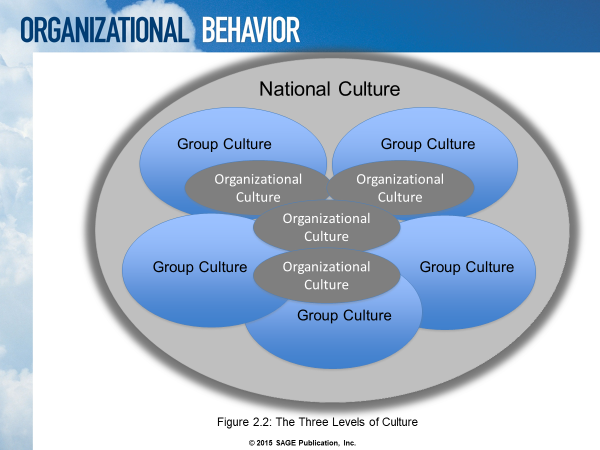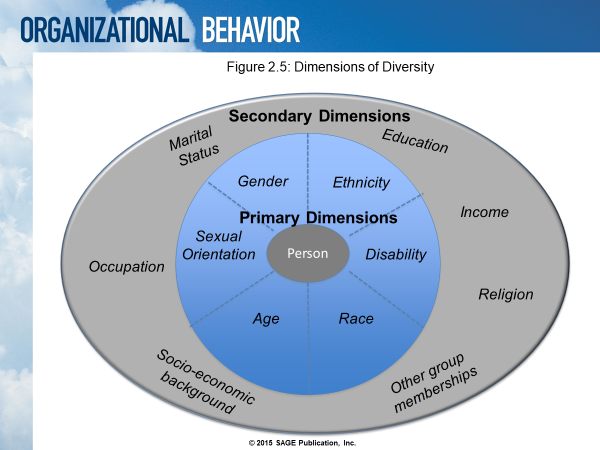Unit 7 The Ethical Challenge of Diversity - Leading Responsibly Across Cultures
Overview
In this unit, we reflect on Ethical Challenges of Diversity and Culture. Culture and cultural diversity play a key role in in the success of organizations. On an individual basis, learning to interact successfully with many cultures can expand one’s perspective and open up many opportunities. On an organizational basis, being able to manage across cultures is imperative. Managing diversity has become a core part of organizational leadership to reduce exclusivity, and implicit bias. Exclusivity pertains to the exclusion of people based on their gender, ethnicity, race, sexual orientation and age. The way we think about ourselves, and our identity, and what aspects define us are important. I think when you pose the question of diversity in this way, it forces people to think about what makes up their own identity. Our thoughts on identity shape our opinions, beliefs and interactions with others in the workplace.
Learning Outcomes
When you have completed this unit, you should be able to:
- Analyze the relationship between cultural values and ethical choices.
- Describe some strategies for making choices in cross-cultural settings.
- Identify how leaders and employees with diverse world-views have different approaches to problem solving.
- Explain some strategies businesses can employ to address the complex issues they face in an increasingly global world.
- Analyze how managers can bring about change while still maintaining a sense of responsibility and whether this can be carried out in a way that avoids coercion, manipulation, or dehumanization.
Topics
This unit is divided into the following topics:
- Diversity in Organizations
- The Dark Side of Globalization
- Leadership and Ethical Diversity
- Global Ethics
Activity Checklist
Here is a checklist of learning activities you will benefit from in completing this unit. You may find it useful for planning your work:
Learning Activities
-
Read & Reflect: Read Chapter 11 from your
Meeting the Ethical Challenge of Leadership text.
-
Read & Reflect: This reading, from the
Journal of Career Assessment highlights some challenges faced
in the modern workplace.
-
Read & Reflect: Read Chapter 8 from your
Responsible Leadership text.
-
Read & Reflect: This article, from The
International Journal of Cross Cultural Management, focuses on
cross-cultural conflict in the workplace.
-
Watch & Reflect: This video defines the term
“culture” so we can better understand it in our capacity as a
leader.
-
Watch & Reflect: This video discusses some
strategies you can employ to “win other’s over” as you initiate
organizational change.
-
Read & Reflect: This article highlights some
important points to consider for leader’s wishing to cultivate
organizational change.
- Learning Lab: The focus of this unit’s learning lab will be a discussion. To prepare for this Learning Lab, please select the Learning Lab tab and look for the guiding question. Be prepared to share your thoughts.
Assessment
- Discussion Forum Post: For your assessment in this unit, you will be asked to submit a forum discussion post. The question that will guide your response can be found by selecting the Assessment tab.
Resources
Here are the resources you will need to complete this unit.
- Johnson, C. E. (2021). Meeting the Ethical Challenge of Leadership: Casting Light or Shadow. 7th Ed, Sage Publication Inc. - ISBN: 9781544351643 (alk. paper)
- Maak, T.& Pless, N. M. (2006). Responsible Leadership. Routledge. - ISBN: 978-0-415-35581-0
- Other online resources will be provided in the unit.
7.1 Diversity in Organizations
Over the past decades, globalization has significantly influenced organizations and, by correlation, leadership strategies within these organizations. Globalization has undoubtedly led to increased diversity which, in turn, requires organizational awareness. In Managing Diversity, (Arthur 2019) asserts that diversity is ever present within organizations; globalization and other sociopolitical factors contribute to increasing diversity within organizations. More women, ethnic minorities and generations have entered the workforce in recent years (Jackson & Ruderman, and Carnevale & Stone, as cited in Levi, 2017) resulting in greater workplace diversity. Cultural differences (for example, individualistic verses collectivistic cultures) affect an individual’s ethical perspective (Johnson, 2018; Sackmann, 2006) and the generation they are part of affects what they value at work (Hansen & Leuty, 2012). Additional work differences exist within teams such as pacing style diversity (Gevers, Rispens & Li, 2016) and personality differences. Additionally, multinational countries operate across country border increasing the cultural diversity in an organization both internally and externally.
In navigating organizational norms, levels of culture are critical to sustain a healthy balance environment. The diagram below helps to explain (this will also be discussed in the video):

- The first level of culture is national culture, the set of values and beliefs shared by people within a nation.
- Ethnic or group cultures form the second level of culture and have their own unique culture.
- The third level of culture is organizational culture, defined as the set of values, norms, and beliefs shared by members of an organization.
In addition, it is important to identify the different dimensions of diversity. It is critical that leaders develop a sense of awareness of these complexities as they are quite dynamic in nature. The following image helps to explain (this will also be reviewd in the video below):

- The primary dimensions of diversity are the visible and stable aspects of a person.
- The secondary dimensions of diversity are less visible or more dynamic.
The video below explains more:
Learning Activity - Read and Reflect
We begin with our first reading from our Meeting the Ethical Challenge of Leadership: Casting Light or Shadow text. Read Chapter 11 and think about how it connects to some of the concepts and examples discussed in the video above.
Learning Activity - Read and Reflect
Next, we have an article from the Journal of Career Assessment that illustrates and example of the challenges faced in the modern workplace. This particular analysis focuses on age (generational diversity) that is becoming more common in organizations. Click on the link below:
7.2 The Dark Side of Globalization
Arguably, the most influential trend of the 21st Century has been the results of globalization. While it is difficult to argue against the many benefits resulting from increased globalization, critics also have valid contention - particularly, how the focus on profit in a globalized world has overshadowed ethical behaviour.
As leaders, it is critical that this influence is acknowledge so that organizations can focus awareness to avoid the “dark side” of globalization.
The following video stresses some of the challenges we need to be aware of:
Learning Activity - Read and Reflect
Take a moment to read through Chapter 8 in your Responsible Leadership text. Again, as you read through this chapter, try to think of experiences in your own life and how this content relates to our study in Unit 6.
7.3 Leadership and Ethical Diversity
It is important to take a moment to actually define “culture.” The term “culture” is quite complex but it does require some reflection. Important to us, here, is to appreciate that different cultures orient their values in a different way then what we, as individuals, might be familiar with. This becomes an important awareness for us in our capacity as a leader. Being aware of these variations in the orientation of values will help better us better respond to challenges that may arise.
By the same understanding, however, it is also imperative that we developing an understanding of the similarities that are shared as well - this will help prevent overgeneralizations that decrease productivity and prevent ethical behaviour. Despite the diversity of the orientation of values within our workplace, it is important that leaders identify the overwhelming shared values that most cultures and ethnicities share - they may be framed slightly different but, ultimately, their foundation is common amongst diverse cultural groups. By embracing these similarities, leaders promote a positive organizational culture that focuses on ethical productivity rather than the cultural differences of a diverse organization.
Take a look:
Learning Activity - Watch and Reflect
This video helps better support our understanding of the term “culture.” In it, we explore three classic definitions of the term culture. As you watch, think about what culture means to you.
Watch: Working in a Culturally Diverse Environment: What is Culture?
7.4 Global Ethics
This final section of Unit 7 turns our attention to the process of making ethical choices in culturally diverse settings. In the video below, for this section, you will see a framework that considers all the complexities of making an ethical decision. You will also be introduced to the philosophy of metaethics - through this lens you will better understand the important cultural considerations that need to go into making an ethical decision.
Learning Activity - Watch and Reflect
In this video, Dr. John Kotter discusses some strategies to “win over others” to guide organizational change. As you watch, think about some of the challenges you might anticipate if you were attempting to bring about cultural change within your organization.
Watch: John Kotter - The Heart of Change
Learning Activity - Read and Reflect
Finally, we have an opportunity to look at a specific model for organizational change. This research article highlights some important considerations for leaders who wish to cultivate change within their organization. Take a look:
Note: This resource can be accessed by logging into the TWU Library catalogue.
Assessment
Formal assessment of the content discussed this unit will take place in the form of a Discussion Forum. For this assignment, you will be asked to draw upon your understanding of the content from Unit 7, as well as any insights you gained during our Learning Lab for this unit.
Your Discussion Forum response will address the following:
Explain why managing diversity is the “core” of modern organizational leadership.
Your response should include direct references and connections to the readings, notes, videos, discussions provided throughout the unit. The rubric below provides more information:
The rubric below will be used to assess your discussion.
Grading Rubric - Click to expand
| Exceeds expectations | Meets Expectations | Minimally Meets Expectations | Does Not Meet Expectations |
|---|---|---|---|
| Addresses the questions or problems that are posed in an insightful manner | Addresses the questions or problems that are posed | Addresses some the questions or problems that are posed | Does not address the questions or problems that are posed |
| Clear, precise and well-reasoned responses | Mostly clear, precise and well-reasoned responses | Some clear, precise and well-reasoned responses | Responses lack clarity, logic and/or precision |
| Demonstrates independent thought, insight, and creativity (applies course concepts, raises questions, recognises competing perspectives, and evaluates implications) | Demonstrates some independent thought, insight, and creativity | Demonstrates a minimal amount of independent thought, insight, and creativity. | Response lacks independent thought, insight, and creativity |
| Spelling and grammar are accurate. | Minor and/or few spelling or grammatical errors. | Several spelling or grammatical errors. |
To submit your response, scroll to the bottom of the screen and click on the “Unit 7 - Discussion Forum” dropbox.
Checking for Learning
Before moving on to the next unit, be sure you are able to:
-
Analyze the relationship between cultural values and ethical
choices.
-
Describe some strategies for making choices in cross-cultural
settings.
-
Identify how leaders and employees with diverse world-views have
different approaches to problem solving.
-
Explain some strategies businesses can employ to address the complex
issues they face in an increasingly global world.
- Analyze how managers can bring about change while still maintaining a sense of responsibility and whether this can be carried out in a way that avoids coercion, manipulation, or dehumanization.